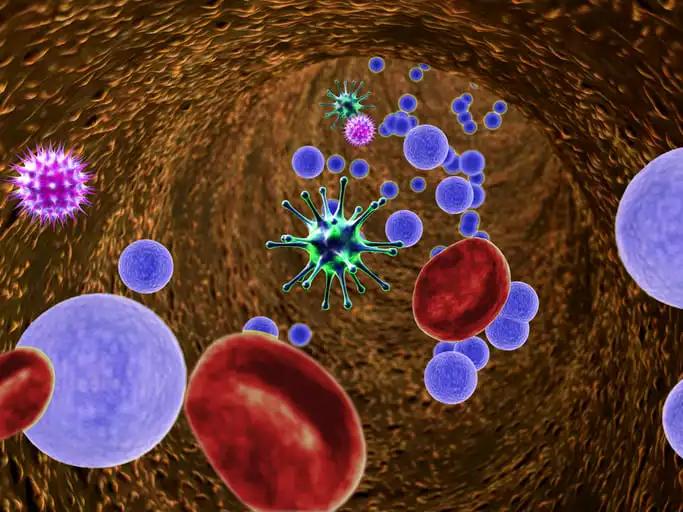KEY TAKEAWAYS
- The SIMPLIFY 2 phase 3 trial (NCT02101268) aimed to compare the effectiveness and safety of momelotinib, a JAK 1 and JAK 2 inhibitor, to the BAT in patients with myelofibrosis who had inadequate responses to ruxolitinib or experienced hematological side effects. And also assess the change in spleen size after 24 weeks of treatment compared to baseline.
- Eligible patients had prior treatment with ruxolitinib for at least 28 days, required red blood cell transfusions or ruxolitinib dose reduction due to thrombocytopenia, anemia, or bleeding, had a palpable spleen of at least 5 cm, and did not have grade 2 or more significant peripheral neuropathy.
- Of the BAT group, 89% received ruxolitinib. The 24-week treatment phase was completed by 70% of patients in the momelotinib group and 77% in the BAT group.
- The study concluded that it did not demonstrate a significant difference in spleen size reduction between momelotinib and BAT groups at 24 weeks.
Janus kinase (JAK) inhibitor ruxolitinib is the only treatment for myelofibrosis cleared by the FDA. After ruxolitinib fails, though, there aren’t many other ways to treat the patient. We compared the effectiveness and safety of momelotinib, a JAK 1 and JAK 2 inhibitor, to the best available treatment (BAT) in people with myelofibrosis who had less-than-ideal responses to ruxolitinib or hematological side effects. In this randomized, phase 3, open-label study, people from 52 clinical centers in Canada, France, Germany, Israel, Italy, Spain, the UK, and the USA were checked to determine eligibility. Patients who had myelofibrosis and previous ruxolitinib treatment for at least 28 days who either required red blood cell transfusions while on ruxolitinib or ruxolitinib dose reduction to less than 20 mg twice a day with at least one of grade 3 thrombocytopenia, anemia, or bleeding at grade 3 or worse, with the palpable spleen of at least 5 cm and without grade 2 or more significant peripheral neuropathy were included in the study. Patients were given either 24 weeks of open-label momelotinib 200 mg once a day or BAT (which could consist of ruxolitinib, chemotherapy, steroids, no treatment, or other standard treatments). After that, all patients could get longer momelotinib treatment. Patients were randomly given therapy through a live web-based response system. The randomization was based on how much they needed blood transfusions and their total symptom score (TSS) at the start of the study. The results were looked at using the “intention to treat” method. The main goal was for the size of the spleen to be at least 35% smaller at 24 weeks than it was at the start. As part of safety analyses, tracking of adverse events was done. ClinicalTrials.gov has given the study the number NCT02101268.
From June 19, 2014, to July 28, 2016, 156 people participated in the study. Of those, 104 got momelotinib, and 52 got BAT. The BAT was ruxolitinib in 46 (89%) of the 52 cases. The 24-week treatment phase was finished by 73 (70%) of the 104 momelotinib group and 40 (77%) of the 52 patients in the BAT group. About 7 (7%) of 104 patients in the momelotinib group and two (6%) of 52 patients in the BAT group had a decrease in spleen size of at least 35% compared to baseline (percentage difference [Cochran-Mantel-Haenszel method], 0·01; 95% CI -0·09 to 0·10), p=0·90). Anemia (14 [14%] of 104 in the momelotinib group vs seven [14%] of 52 in the BAT group), thrombocytopenia (7 [7%] vs 3 [6%]), and abdominal pain (one [1%] vs three [6%]) were the most common side effects of grade 3 or worse. Peripheral neuropathy happened to 11 (11%) of the 104 who took momelotinib, and one of those had a grade 3 case. This did not occur to anyone in the BAT group. About 36 (35%) of the people in the momelotinib group and 12 (23%) in the BAT group had severe events. Deaths due to adverse events were reported for 6 patients (6%) receiving momelotinib (acute myeloid leukemia [n=2], respiratory failure [n=2, with one considered possibly related to momelotinib], cardiac arrest [n=1, considered possibly related to momelotinib], and bacterial sepsis [n=1]); and four patients (8%) receiving BAT (lung adenocarcinoma [n=1], myelofibrosis [n=1], and sepsis [n=2]). The study concluded that there is no significant difference in spleen size reduction between momelotinib and BAT groups at 24 weeks.
Source: https://pubmed.ncbi.nlm.nih.gov/29275119/
Clinical Trial: http://clinicaltrials.gov/show/NCT02101268
Harrison CN, Vannucchi AM, Platzbecker U, Cervantes F, Gupta V, Lavie D, Passamonti F, Winton EF, Dong H, Kawashima J, Maltzman JD, Kiladjian JJ, Verstovsek S. Momelotinib versus best available therapy in patients with myelofibrosis previously treated with ruxolitinib (SIMPLIFY 2): a randomized, open-label, phase 3 trial. Lancet Haematol. 2018 Feb;5(2):e73-e81. doi: 10.1016/S2352-3026(17)30237-5. Epub 2017 Dec 20. PMID: 29275119.



